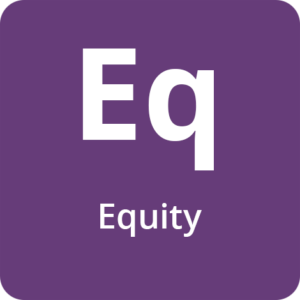 Equity, while a goal of many local wellness funds and community-based collaboratives, remains elusive. There is no single definition of equity, no single measurement of equity, and certainly no known strategy to achieve it.
Defining Equity
Equity is defined by the World Health Organization as “the absence of avoidable or remediable differences among groups of people, whether those groups are defined socially, economically, demographically, or geographically.”¹ This definition is outcomes focused and lends itself to using improvements in health disparities as a measure of success.
Others, call greater attention to the inputs or root causes of inequity. For example, the Prevention Institute defines health equity as a condition in which “everyone has a fair and just opportunity to be healthy. This requires removing obstacles to health such as poverty, discrimination, and their consequences — including powerlessness and lack of access to good jobs, education, housing, environments, and health care.”²
Whether equity is viewed as an input (opportunity) or an output (outcome), there is broad recognition that factors outside of health care need to be addressed to achieve equity. Racial equity is inextricably linked to achievement of health equity.
In addition to focusing on interventions (e.g., policies, programs) that aim to alleviate inequities in outcomes, processes can promote equity. Procedural equity is the ways in which the power to shape collective action is shared among parties within the collaborative.³ By being mindful of procedural equity, local wellness funds will also foster power sharing, community voice, trust, and accountability to the community they serve.
Equity, as measured by both processes and outcomes, can be thought of as a continuum from inequitable to fully equitable. Local wellness funds can move along this continuum by incorporating equity-focused strategies for knowledge building and vision sharing, assessment and measurement, and action.
Equity, while a goal of many local wellness funds and community-based collaboratives, remains elusive. There is no single definition of equity, no single measurement of equity, and certainly no known strategy to achieve it.
Defining Equity
Equity is defined by the World Health Organization as “the absence of avoidable or remediable differences among groups of people, whether those groups are defined socially, economically, demographically, or geographically.”¹ This definition is outcomes focused and lends itself to using improvements in health disparities as a measure of success.
Others, call greater attention to the inputs or root causes of inequity. For example, the Prevention Institute defines health equity as a condition in which “everyone has a fair and just opportunity to be healthy. This requires removing obstacles to health such as poverty, discrimination, and their consequences — including powerlessness and lack of access to good jobs, education, housing, environments, and health care.”²
Whether equity is viewed as an input (opportunity) or an output (outcome), there is broad recognition that factors outside of health care need to be addressed to achieve equity. Racial equity is inextricably linked to achievement of health equity.
In addition to focusing on interventions (e.g., policies, programs) that aim to alleviate inequities in outcomes, processes can promote equity. Procedural equity is the ways in which the power to shape collective action is shared among parties within the collaborative.³ By being mindful of procedural equity, local wellness funds will also foster power sharing, community voice, trust, and accountability to the community they serve.
Equity, as measured by both processes and outcomes, can be thought of as a continuum from inequitable to fully equitable. Local wellness funds can move along this continuum by incorporating equity-focused strategies for knowledge building and vision sharing, assessment and measurement, and action. 
Equity, while a goal of many local wellness funds and community-based collaboratives, remains elusive. There is no single definition of equity, no single measurement of equity, and certainly no known strategy to achieve it.
Defining Equity
Equity is defined by the World Health Organization as “the absence of avoidable or remediable differences among groups of people, whether those groups are defined socially, economically, demographically, or geographically.”¹ This definition is outcomes focused and lends itself to using improvements in health disparities as a measure of success.
Others, call greater attention to the inputs or root causes of inequity. For example, the Prevention Institute defines health equity as a condition in which “everyone has a fair and just opportunity to be healthy. This requires removing obstacles to health such as poverty, discrimination, and their consequences — including powerlessness and lack of access to good jobs, education, housing, environments, and health care.”²
Whether equity is viewed as an input (opportunity) or an output (outcome), there is broad recognition that factors outside of health care need to be addressed to achieve equity. Racial equity is inextricably linked to achievement of health equity.
In addition to focusing on interventions (e.g., policies, programs) that aim to alleviate inequities in outcomes, processes can promote equity. Procedural equity is the ways in which the power to shape collective action is shared among parties within the collaborative.³ By being mindful of procedural equity, local wellness funds will also foster power sharing, community voice, trust, and accountability to the community they serve.
Equity, as measured by both processes and outcomes, can be thought of as a continuum from inequitable to fully equitable. Local wellness funds can move along this continuum by incorporating equity-focused strategies for knowledge building and vision sharing, assessment and measurement, and action.
How to Develop an Equity-Oriented Mindset
Before equity can be achieved, collaboratives must share a common understanding of where inequities exist, why they exist, and what there is political willingness to do about it. A Georgia Health Policy Center literature review highlights that barriers to achieving equity can exist at the individual, organizational, and system level.
- At the individual level, knowledge gaps and a failure to prioritize equity are the most common barriers.
- At the organizational level, the lack of coordination within and between organizations is a barrier to reducing health disparities. Lack of a common approach is exacerbated by differences in organizational responsibilities and program objectives. Further, power imbalances between collaborating organizations and the communities they are intended to help may result in the marginalization of community voice, which ultimately will be a barrier to achieving equity.
- At the systems level, policies that foster siloes and do not support cross-sector collaboration perpetuate a non-holistic view of health and fail to comprehensively address the full spectrum of socioeconomic drivers of health thus perpetuating health disparities.³
The literature review also identified solutions that can overcome these barriers.
- At the individual level trainings can potentially overcome knowledge gaps, particularly by integrating understanding of historical drivers of inequity and the resulting structural challenges.
- At the organizational level, strategies can include power sharing and the inclusion of community voice (those with lived experience) not merely in a token way but in collaborative decision-making. Enhancing transparency and building trust with the community being served, in turn, will further proliferate opportunities for inclusion of community voice.
- At the systems level, strategies that incorporate a Health in All Policies orientation and that foster cross-sector alignment are necessary. The health care delivery system alone cannot create health equity and without broader racial equity in the social determinants of health, health equity will not be achieved.
It warrants further mention that a health equity mindset is difficult to accomplish without a deep understanding of the groups in the community that are experiencing conditions that are creating disparities. In order to gain that deep understanding, those with first-hand knowledge and experience need to be fully included in the process as an equally valued perspective.
If broad inclusion is not present in the planning team, local wellness funds can take steps to broaden diversity. People with lived experience are the experts at understanding what structural and societal issues that are impacting health outcomes.
Partnership Assessment Tool for Health: Advancing Health Equity
Nonprofit Finance Fund developed an addendum to their Partnership Assessment Tool for Health that focuses on partnerships’ ability to advance health equity. This new section identifies benchmarks characteristic of partnerships working effectively to advance health equity, as well as guiding questions for partnerships to consider in assessing their development in this area. Local wellness funds may find the questions useful to open dialogue within and between partnering organizations around strengths and gaps of the partnership in removing obstacles to health and ensuring opportunities for all.
Communities in Action: Pathways to Health Equity
This report, released by the National Academies of Sciences, Engineering, and Medicine with support from the Robert Wood Johnson Foundation, highlights how community-based solutions (defined an action, policy, law, or program that is driven by the community and affects local factors that can influence health) has the potential to advance health equity. The report identifies nine examples of community-based solutions that address health inequities, all of which share the three important elements: making health equity a shared vision and value, fostering multisector collaboration, and increasing community capacity to shape outcomes. This report offers strategies local wellness funds may be able to incorporate into their uses, partnerships, and influence over policies.
A More Practical Guide to Incorporating Health Equity Domains in Implementation Determinant Frameworks
This article, published in Implementation Science Communications, offers guidance for how to incorporate the Health Equity Implementation Framework into real-life, clinically focused implementation efforts. Examples and practical tools are provided to assist practitioners in applying three health equity domains — culturally relevant factors of recipients, interactions in clinical encounters or patient-provider interaction, and societal context — to as well as suggested sample quantitative and qualitative measures for evaluation purposes. This framework may help local wellness funds capture and understand barriers and facilitators to health inequities.
A Practitioner’s Guide for Advancing Health Equity: Community Strategies for Preventing Chronic Disease
This guide, developed by the Centers for Disease Control and Prevention’s Division of Community Health, focuses on policy, systems, and environmental improvement strategies that can address disparities in chronic disease health outcomes. This resources provides lessons learned and practices from the field, as well as from the existing evidence-base, that may assist local wellness funds by offering ideas for how communities can incorporate the concept of health equity into core components of public health practice, including organizational capacity, partnerships, community engagement; identifying health inequities; and evaluation.
- World Health Organization. (2020). Equity. Retrieved December 12, 2020, from https://www.who.int/healthsystems/topics/equity/en/
- Prevention Institute. (2016). Countering the production of health inequities: A framework for emerging systems to achieve an equitable culture of health: Prevention Institute. Retrieved from https://www.preventioninstitute.org/sites/default/files/publications/Countering%20the%20 Production%20of%20Health%20Inequities%20EXTENDED%20SUMMARY%20FINAL.pdf
- Caldwell, J., Lanford, D., Petiwala, A., Thomas, K. (2020). Equity from a cross-sector alignment perspective: Findings from a literature review. Georgia Health Policy Center. Retrieved from https://ghpc.gsu.edu/download/equity-from-a-cross-sector-alignment-perspective-findings-from-a-literature-review.


